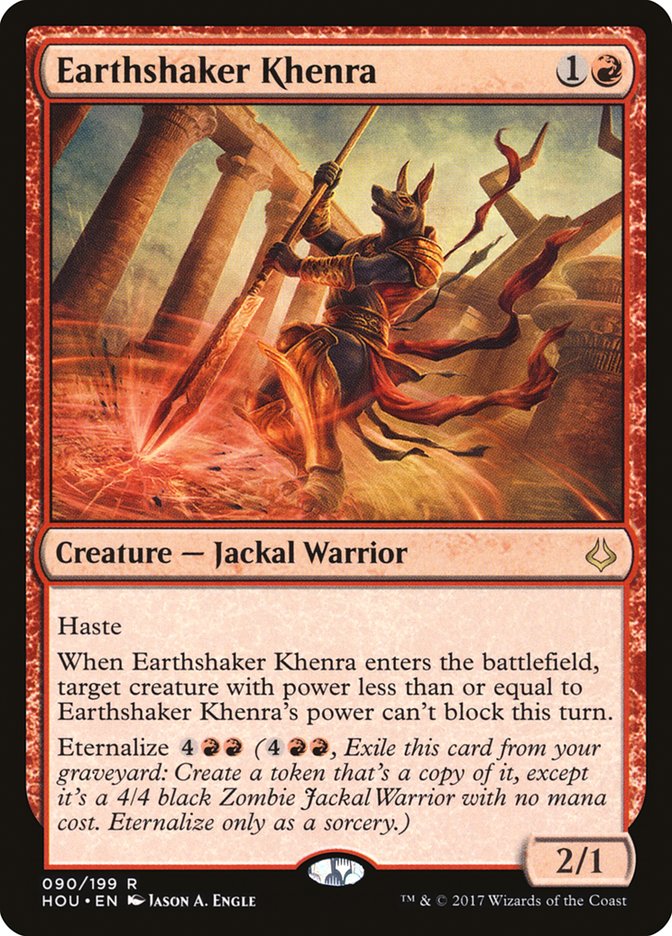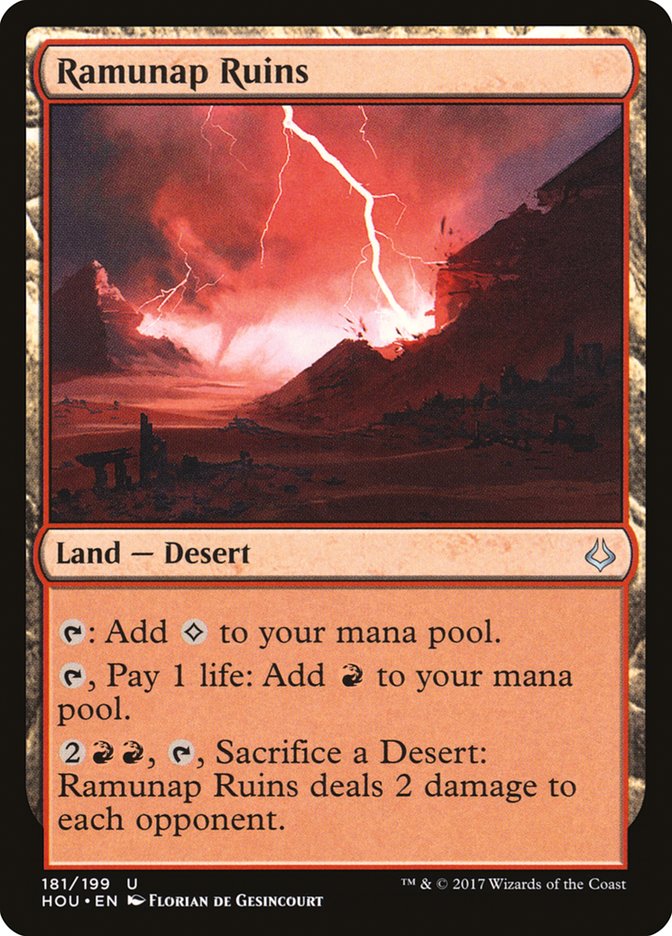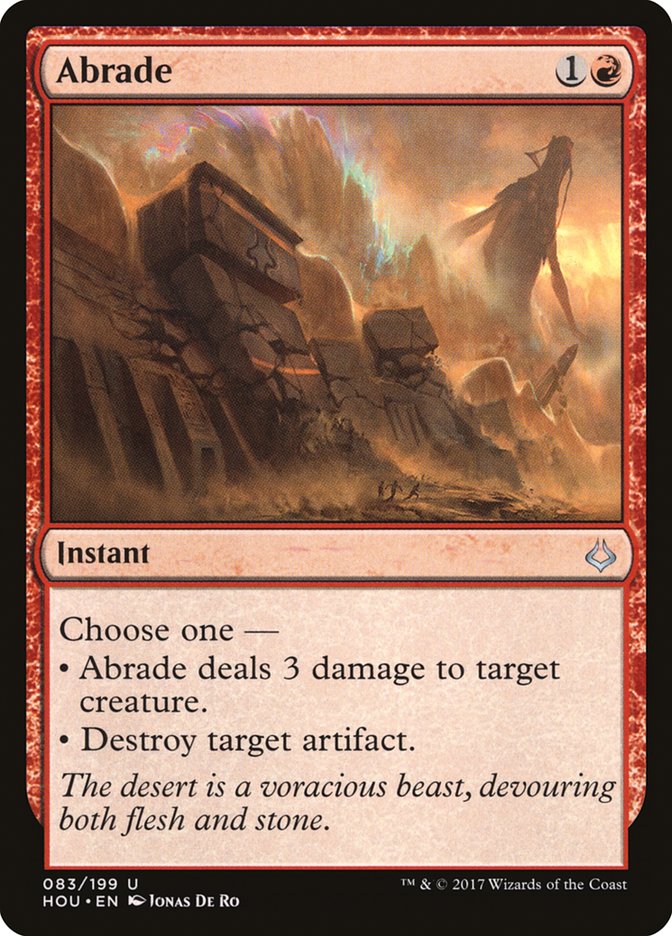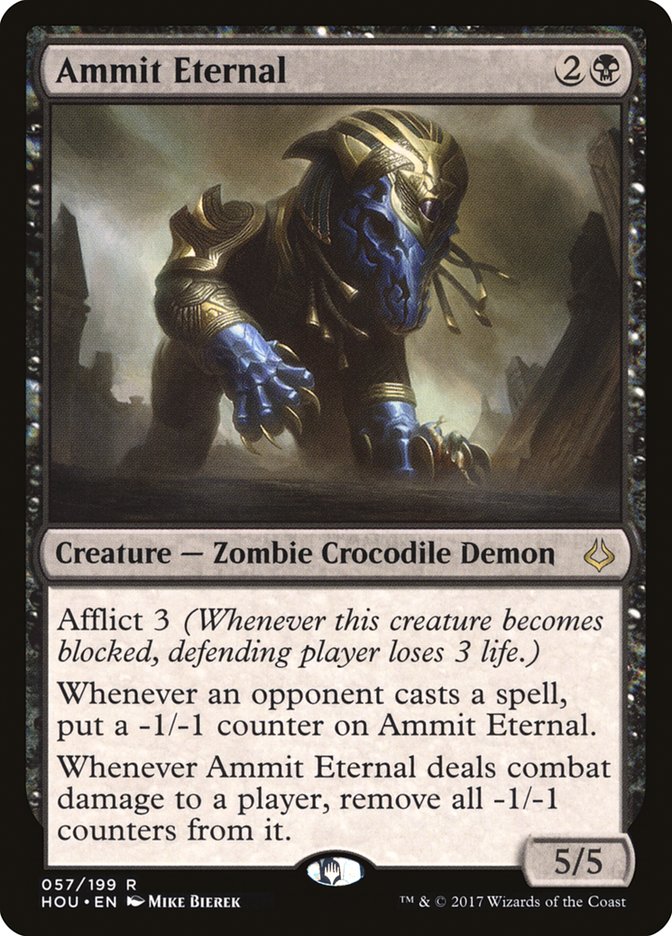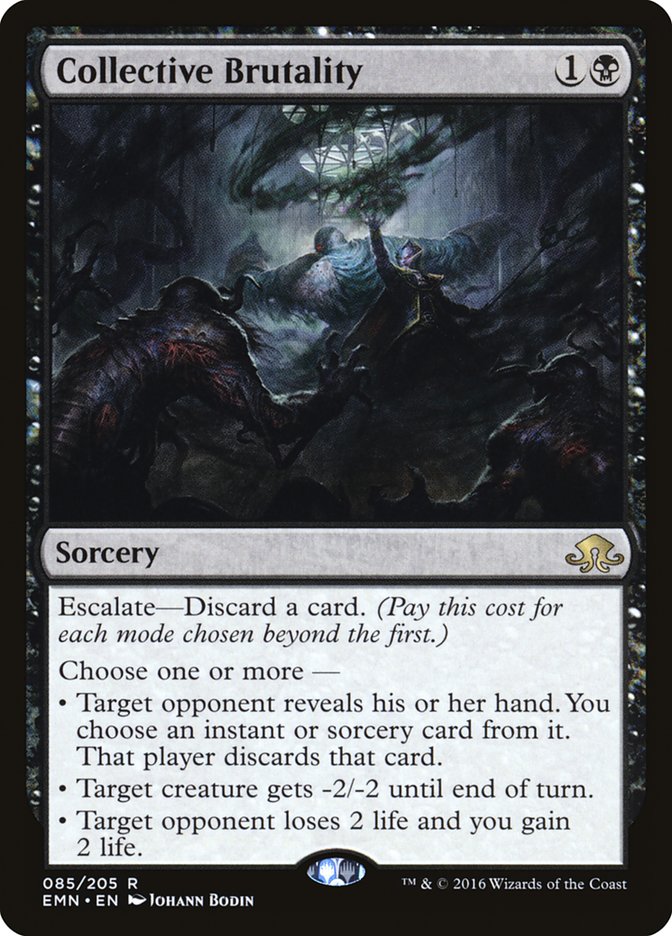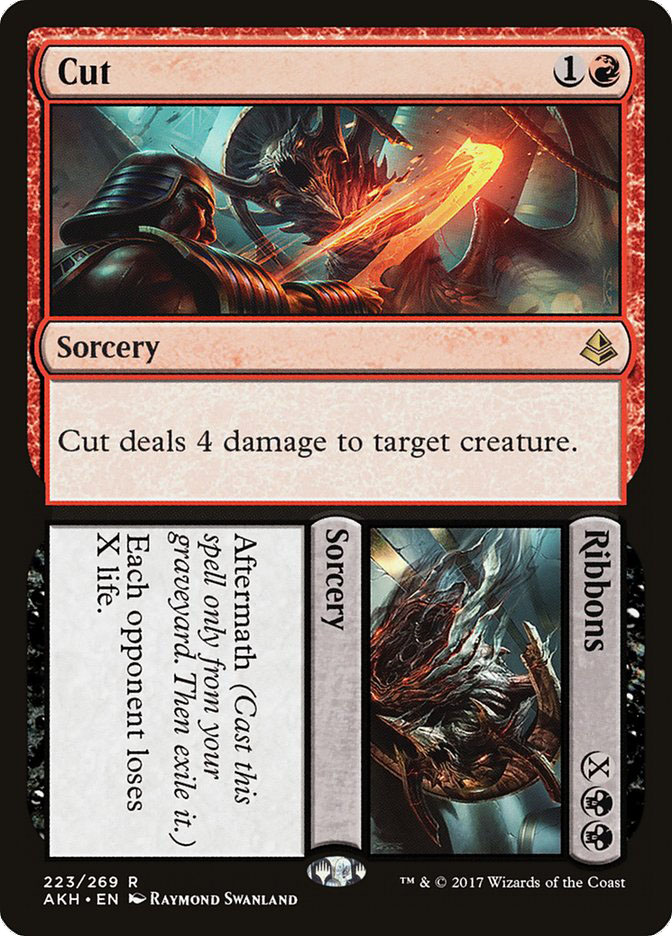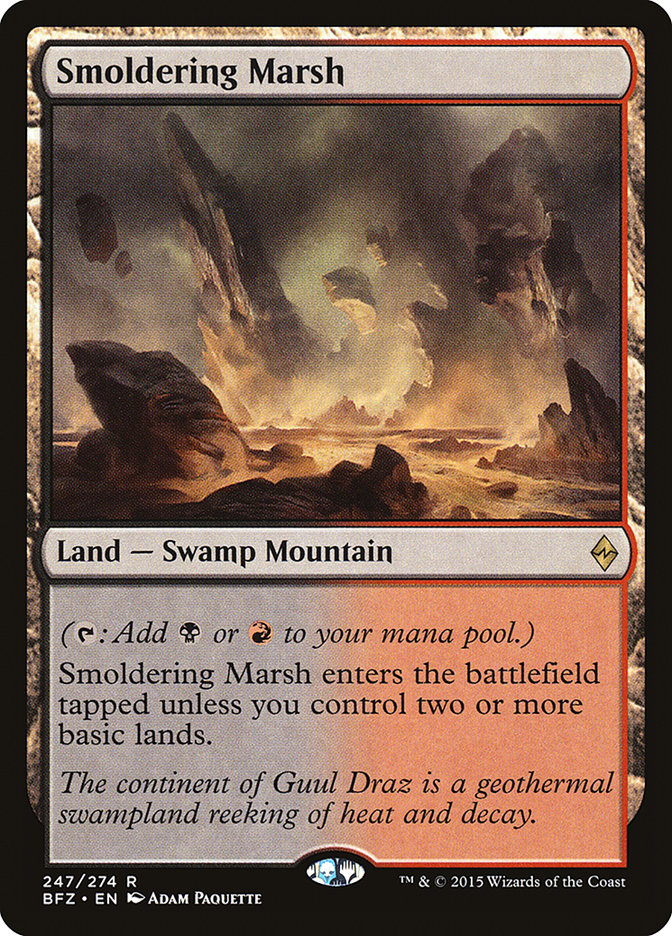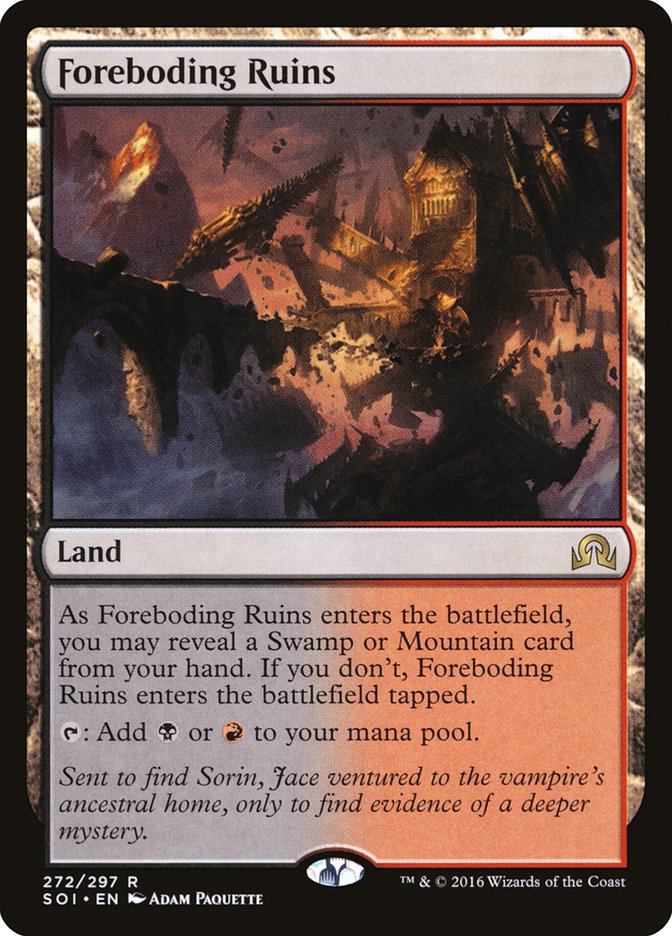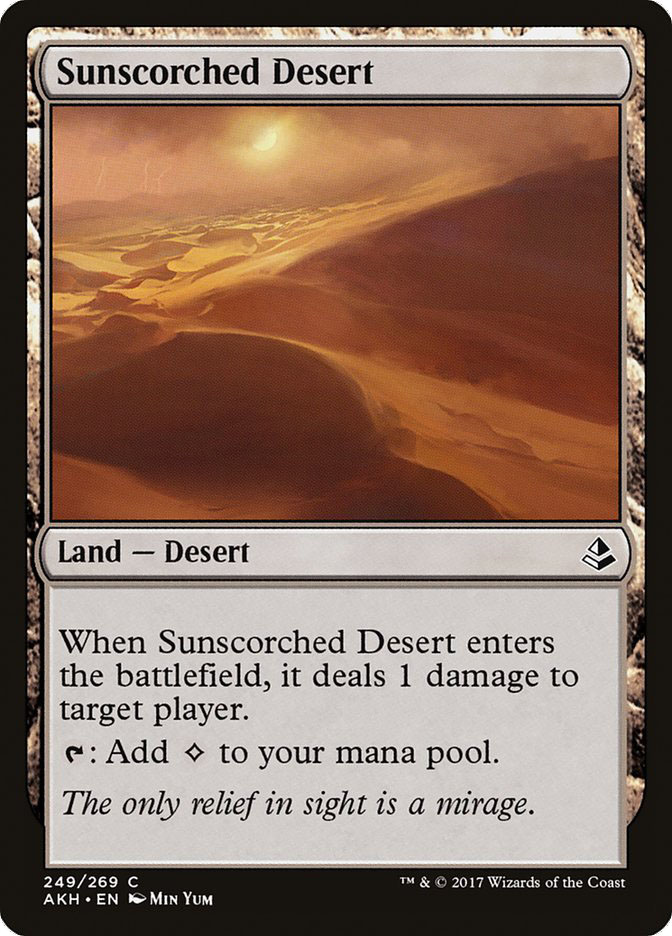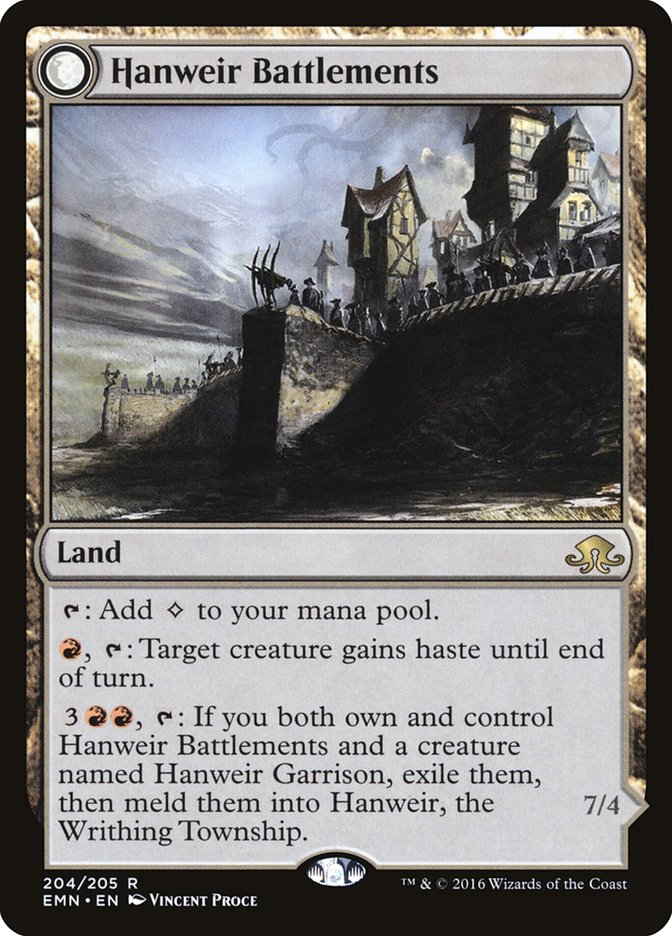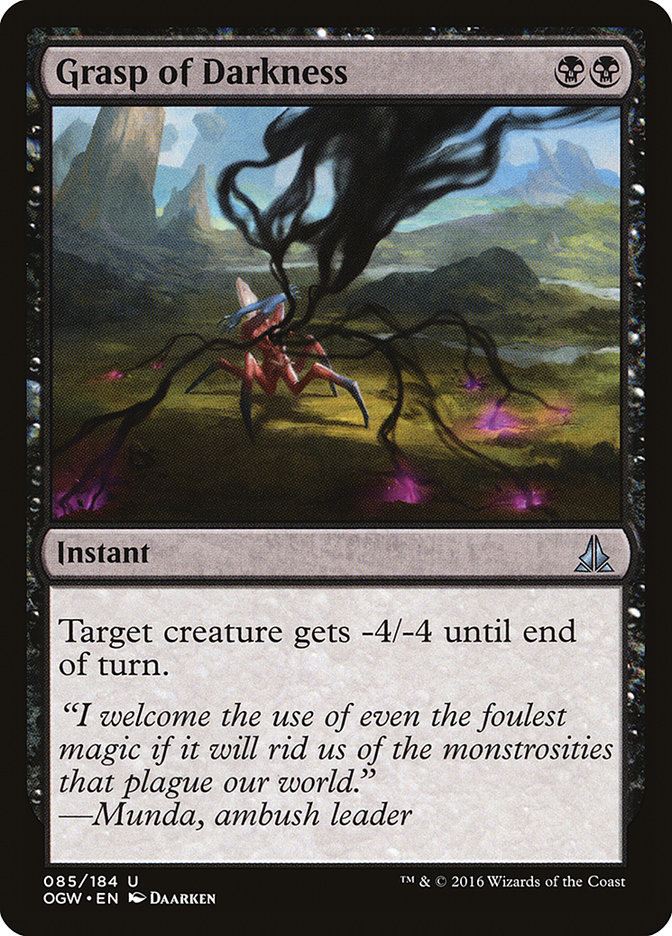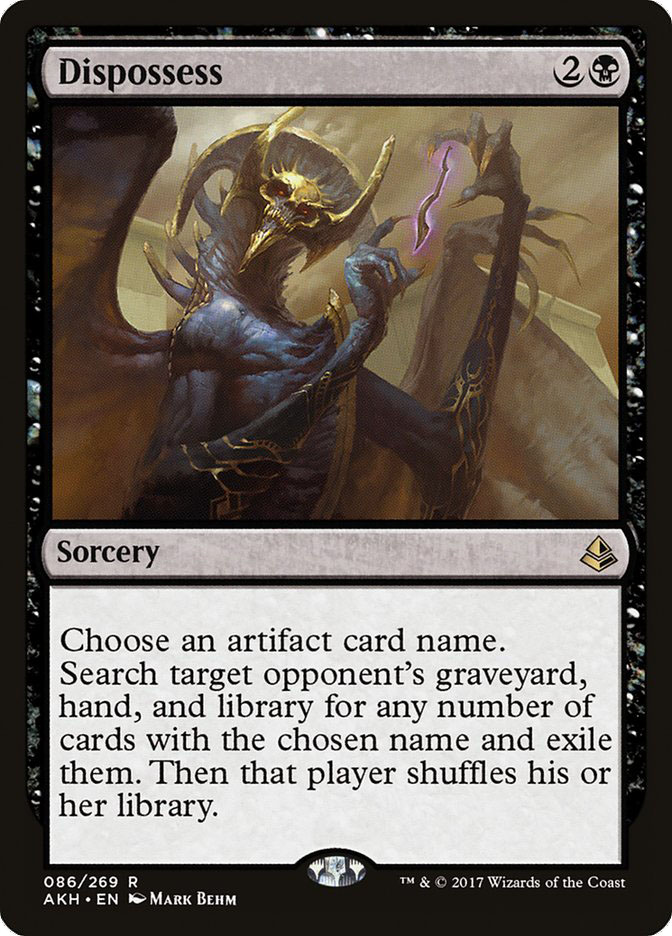Do you like Mountains? No? Then I’d click the back button on your browser…
To say that Ramunap Red destroyed Pro Tour Hour of Devastation is the understatement of 2017. But this isn’t unlike anything we’ve ever seen before. If you turn the dial back, you’ll remember that, just five months ago, Pro Tour Aether Revolt was dominated by Mardu Vehicles, with six copies in the Top 8.
Has Standard become too easy to solve? Maybe yes. Maybe no. When you’ve got great players working together to accomplish the same goal – breaking the Standard format – it doesn’t really come as much of a surprise to see all these great minds figure things out quickly. The fact that all the versions of Ramunap Red that made it to the elimination rounds were relatively different is worth highlighting, and I’ll be going over those differences shortly, but more than anything, I’m just glad that Standard is fun to play and interesting to watch again.
For so long, Standard was a boring format to play and even more boring to watch. I can only speak for myself, but I really couldn’t stand playing against or watching Aetherworks Marvel, Felidar Guardian, or Emrakul, the Promised End for long, so to see WotC address those problems quickly is very much appreciated. As a result, I think we have one of the healthiest Standard formats in years. When a Mono-Red Aggro deck is the deck to beat, you’re generally in a very good place, and while Ramunap Red is one helluva deck, it is quite beatable.
Today, I’ll be doing my usual:
1. Breaking down each Top 8 deck
2. Sharing what I like and dislike about each Top 8 deck
3. Giving my thoughts on how to move forward in Standard to ensure success
Let’s get started!
Creatures (23)
- 4 Falkenrath Gorger
- 4 Bomat Courier
- 2 Kari Zev, Skyship Raider
- 3 Hazoret the Fervent
- 4 Ahn-Crop Crasher
- 2 Soul-Scar Mage
- 4 Earthshaker Khenra
Planeswalkers (2)
Lands (9)
Spells (26)

Unsurprisingly, we’ll be kicking things off with the first of many Rumunap Red decks. For former World Champion Seth Manfield, his tournament ended on a bittersweet note, as he blew a Golden State Warriors-esque lead over Paulo Vitor Damo Da Rosa in the quarterfinals. But don’t let those 3-1 memes take away from the fact that Manfield had another amazing tournament with a color he loves to play more than people seem to realize.
These three red cards from Hour of Devastation are a huge reason why Ramunap Red is even able to exist in the first place. Prior to the arrival of Hour of Devastation, mono-red strategies existed but they simply weren’t powerful enough to contend with the likes of Gideon, Ally of Zendikar; Heart of Kiran; or Aetherworks Marvel. But with a banning here, a metagame shakeup there, and the introduction of some abstractly powerful red cards, Ramunap Red was born!
But what I feel is incredibly important to note is that Ramunap Red isn’t your ordinary aggressive red deck. For me, aggressive red decks fall into a few categories:
1. Average power level and a fine choice within a metagame
2. Low power level and attempting to take advantage of a very specific metagame
3. High power level and setter of the metagame
To illustrate my point, let’s take a look at an example of each. First, here’s an aggressive red strategy that I consider to be of an average power level and was a totally fine choice within its metagame:
Creatures (15)
- 1 Frenzied Goblin
- 4 Foundry Street Denizen
- 2 Goblin Rabblemaster
- 4 Monastery Swiftspear
- 1 Lightning Berserker
- 3 Zurgo Bellstriker
Lands (20)
Spells (25)

While this Atarka Red decklist by Martin Dang did win a Pro Tour, we’re looking at a pretty average deck power level wise. There are some very powerful cards (Goblin Rabblemaster, Monastery Swiftspear, Stoke the Flames); some average cards (Lightning Strike, Atarka’s Command, Hordeling Ourburst); and some stinkers that work within the context of the deck and the format (Dragon Fodder, Foundry Street Denizen, Zurgo Bellstriker). Overall, there’s nothing wrong with this deck from a power level standpoint, but it certainly doesn’t blow you away either. Atarka Red ended up being a solid choice within its metagame but was never Public Enemy Number One.
Now let’s take a look at an aggressive red strategy that I consider to have a low power level and was attempting to take advantage of a very specific metagame:
Creatures (16)
Lands (8)
Spells (36)
Sideboard

Back when Jund was the deck to beat in Standard almost eight years ago, people went towards aggressive red decks that looked like what you see above to try and get an edge. Just like Modern Jund nowadays, Standard Jund was loaded with removal, so having creatures that were going to die anyway and could come back for more via unearth was a way to mitigate that aspect of the deck.
With regards to card quality, this take on an aggressive red strategy did have some really powerful cards (Goblin Guide, Lighting Bolt, and Searing Blaze still see play in Eternal formats) but was mostly filled with garbage that wouldn’t see play nowadays (here’s looking at you, Earthquake and Quenchable Fire). But the biggest problem with this deck was that it didn’t even always beat Jund! Jund was so absurdly good back in the day that it really did beat everything and more often than not wiggled its way out of trouble when paired against this red strategy that existed solely to prey on the three-color menace.
Last, let’s take a look at an aggressive red strategy with a high power level that sets the metagame around it:
Creatures (24)
- 4 Magus of the Scroll
- 4 Blood Knight
- 4 Magus of the Moon
- 4 Ashenmoor Gouger
- 4 Demigod of Revenge
- 4 Figure of Destiny
Lands (24)
Spells (12)
Sideboard

This aggressive red deck by Michael Jacob was not to be trifled with. It had everything that one could really ask for in an aggressive red deck in a Standard format. Your one-drops, Magus of the Scroll and Figure of Destiny, were good on turn 1 and only got better as the game went on. Your two-drops, Blood Knight and Figure of Destiny (yes, it is also a two-drop!), had relevant text and sizing. Your three-drops, Magus of the Moon and Ashenmoor Gouger, could win the game on their own in certain circumstances. And don’t even get me started with Demigod of Revenge…
But then there’s the reach that Flame Javelin and Incinerate provide, along with the efficiency of Skred. Incendiary Flow, Collective Defiance, and Magma Spray are all nice cards, but Flame Javelin, Incinerate, and Skred make one helluva package for red decks to have access to. If memory serves, MJ’s take on Mono-Red dusted everyone up at Nationals on his way to a title and people having to really take what he brought to the table very seriously moving forward.
For me, Ramunap Red falls into the “high power level and sets the metagame itself” camp. We’re talking about a red deck that has a solid aggressive start, makes blocking borderline impossible, and has an absurd late-game due to Chandra, Torch of Defiance; eternalize on Earthshaker Khenra; and the reach that Ramunap Ruins provides. After sideboarding, it has the ability to still go underneath you with a fast start or go over the top with cards like Glorybringer and more copies of Chandra.
This deck is terrifying, and while Seth may not have won the tournament, he certainly had one of the best builds of the deck during his time in Kyoto.
Creatures (23)
- 3 Kalitas, Traitor of Ghet
- 4 Relentless Dead
- 4 Diregraf Colossus
- 4 Cryptbreaker
- 4 Lord of the Accursed
- 4 Dread Wanderer
Lands (24)
Spells (13)

Switching gears from one monocolored deck to another, Yusuke Sasabe’s take on Zombies was one that I immediately fell in love with. Sasabe clearly knew a few things walking into Pro Tour Hour of Devastation:
1. Mono-Red was going to be a popular deck at Pro Tour Hour of Devastation
2. Mono-Black Zombies is a good way to fight Mono-Red while also just being a good deck in general
3. Kalitas, Traitor of Ghet is a great card against Mono-Red, Mono-Black Zombies, and B/G Constrictor
With Gerry Thompson’s win at Pro Tour Amonkhet, I don’t really feel the need to go over the intricacies of Mono-Black Zombies. The deck has a lot of staying power due to Cryptbreaker and Relentless Dead and has access to great removal in Grasp of Darkness and Dark Salvation, but unfortunately it doesn’t have access to a great sideboard because black’s options are rather limited.
So what makes Sasabe’s take on Mono-Black Zombies special? Ignoring the maindeck copies of Kalitas, not a lot. The addition of Ifnir Deadlands is basically a freeroll, and with Aetherworks Marvel banned, the sideboard was able to become a lot more streamlined. But those maindeck copies of Kalitas do deserve our attention, so let’s talk about them for a sec.
With the three big decks of Pro Tour Hour of Devastation being Ramunap Red, Mono-Black Zombies, and B/G Constrictor, Kalitas is as good now as it may ever be in Standard. With that said, I want to warn you that it’s very difficult to expect Kalitas to live after casting it. With Collective Defiance; Chandra, Torch of Defiance; Grasp of Darkness; Never // Return; Dark Salvation; Fatal Push; and Harnessed Lightning all running around the format, the likelihood of Kalitas living strikes me as relatively low.
Does that mean the card is bad? Of course not. If you get to untap with it, your chances of winning the game have risen dramatically. All I’m saying is that, as well-positioned as Kalitas is right now, everyone else playing Standard also knows that Kalitas is well positioned and is prepared to kill it immediately, so don’t rely on it to get the job done against anyone.
One thing I will say after playing Mono-Black Zombies in the MTGO PTQ on Saturday to a disappointing 4-3 finish is that I really think the deck needs a 25th land, because missing your third land drop is basically a death sentence. Between Cryptbreaker, Relentless Dead, Kalitas, Dread Wanderer, Dark Salvation, Liliana’s Mastery, Ifnir Deadlands, and Westvale Abbey, Mono-Black Zombies has plenty to do with its mana and is happy to discard excess lands to Cryptbreaker if it comes down to it. Making that change is obviously difficult because a lot of the cards in the maindeck don’t feel cuttable given the tribal nature of the deck, but if I were to trim on anything, I would consider shaving a Fatal Push or Lord of the Accursed.
Creatures (26)
- 4 Falkenrath Gorger
- 4 Village Messenger
- 4 Bomat Courier
- 3 Kari Zev, Skyship Raider
- 3 Hazoret the Fervent
- 4 Ahn-Crop Crasher
- 4 Earthshaker Khenra
Lands (8)
Spells (26)
Sideboard

Now back to your regularly scheduled program! Comparing Felix’s list to Seth’s, you’ll find the following differences in the maindeck:
Seth’s Deck
Felix’s Deck:
Felix opted for a more aggressive and streamlined take on Ramunap Red with four copies of Village Messenger, four copies of Shock, and a third copy of Collective Defiance and Kari Zev, Skyship Raider, whereas Seth took a more controlling approach with his four copies of Abrade, no copies of Village Messenger, and a few copies of Soul-Scar Mage and Chandra, Torch of Defiance. With this more aggressive and streamlined approach, it ensures that Felix’s build of Ramunap Red does the same thing every game, while Seth’s gameplan can change depending on what he draws.
You’ll also notice that Felix has a very streamlined sideboard as well. Four copies of Kari Zev’s Expertise means that Felix was expecting some type of Ramp deck to be popular in Kyoto. Three copies of Abrade, Magma Spray, and Harsh Mentor also demonstrate that Felix has very strong feelings about these three cards if he was willing to incorporate them in such high numbers.
With how things shook out at Pro Tour Hour of Devastation, I think it’s appropriate to get away from those copies of Kari Zev’s Expertise and Harsh Mentor, as neither card is terribly exciting against the mirror, Mono-Black Zombies, or B/G Constrictor. Ideally, there will be a time and a place for those cards to thrive, but the current metagame isn’t it.
I’d also try to find a way to incorporate a few copies of Chandra in the maindeck. Simply put, the card is much too powerful right now to only be hiding out in the sideboard. Four copies is overkill because of her planeswalker status, but I would certainly want access to three copies throughout my 75 if possible.
Creatures (25)
- 2 Eldrazi Obligator
- 4 Falkenrath Gorger
- 4 Bomat Courier
- 2 Kari Zev, Skyship Raider
- 3 Hazoret the Fervent
- 2 Soul-Scar Mage
- 4 Earthshaker Khenra
- 4 Ammit Eternal
Lands (23)
Spells (12)

Nope. Just nope.
As happy as I am for Kurata for making Top 8 in Kyoto, this is just a worse Ramunap Red deck. The black splash just isn’t terribly beneficial and the mana troubles are a real concern. Let’s take a look at what Kurata is splashing black for first:
Ammit Eternal is probably a lot better than I’m giving it credit for, but, ignoring its cool creature type, nothing about it really excites me. It’s a big creature, sure, but it doesn’t have keywords that I care about (lifelink, deathtouch, etc.) and just being a big creature simply isn’t enough in this metagame. Perhaps I’m missing something obvious, but I have absolutely no interest in splashing for a conditional 5/5.
As for Cut // Ribbons and Collective Brutality, I think both of those cards are fairly well-positioned in the current metagame, but neither is worth splashing for. Technically, Kurata isn’t splashing for Cut // Ribbons because Cut is very castable in his deck, but Ribbons requires a bit more work and strikes me as worse than just having copies of Collective Defiance.
Collective Brutality may be a Modern superstar, but unless the Standard metagame shapes up a very particular way – a metric ton of Ramunap Red and other low-to-the-ground aggressive decks – it’s more of a sideboard card to me. I do think one of the best ways to fight Ramunap Red is the Vicious Hunger / Sorin’s Thirst effect that Collective Brutality provides via escalate because blocking with something like Gifted Aetherborn is hopeless, but I don’t think it warrants maindeck inclusion, let alone splashing for it.
As for those potential mana issues…
Another reason that Ramunap Red and mono-colored decks in general are so appealing is that all of your lands enter the battlefield untapped every single game. Curving out is important in aggressive decks, and when your lands don’t cooperate with that, it can be game-altering and potentially game-losing. By now, we all know that an enemy-colored manabase is more fluid than an ally-colored one in Standard at the moment, but the risk of Smoldering Marsh and Foreboding Ruins entering the battlefield tapped is so high that I simply cannot recommend a black splash on those factors alone, let alone that I don’t like the black cards that are being splashed.
Creatures (25)
- 4 Falkenrath Gorger
- 4 Bomat Courier
- 2 Kari Zev, Skyship Raider
- 3 Hazoret the Fervent
- 4 Ahn-Crop Crasher
- 4 Soul-Scar Mage
- 4 Earthshaker Khenra
Lands (23)
Spells (12)

My favorite player from the Top 8, Yam Wing Chun had himself a blast during the elimination rounds of Pro Tour Hour of Devastation. From tilting viewers with how he drew his card every turn (PS: I loved it) to losing a game to Paulo that made me feel like I had the wind knocked out of me (PS: I didn’t love it), Yam made the most of his time on camera and I’m glad he was there.
As far as Yam’s Ramunap Red decklist is concerned, he basically split the difference between Felix and Seth. Where Felix had four copies of Village Messenger, Yam has four copies of Soul-Scar Mage. Where Seth had a more fluid removal package (4 Incendiary Flow, 2 Collective Defiance, 2 Shock, and 4 Abrade), Yam’s is a lot more streamlined (4 Shock, 4 Incendiary Flow, and 4 Collective Defiance).
Yam’s sideboard is a bit different, with access to Warping Wail and Akoum Firebird. Warping Wail is an interesting inclusion because Ramunap Red masks itself so well that I’m sure that when Warping Wail was good for Yam, it was completely insane and caught his opponents way off guard. As for Akoum Firebird, it gets a big ole meh from me. Flying in the red mirror has historically caught people off guard (Rathi Dragon, Fledging Dragon, etc.), but those creatures were also 5/5 Dragons, whereas Akoum Firebird dies to Incendiary Flow, Abrade, and almost every other removal spell.
It’s gonna be a no for me, dawg.
Creatures (26)
- 4 Falkenrath Gorger
- 4 Village Messenger
- 4 Bomat Courier
- 3 Kari Zev, Skyship Raider
- 3 Hazoret the Fervent
- 4 Ahn-Crop Crasher
- 4 Earthshaker Khenra
Lands (7)
Spells (27)

As Sam Black continues to build his Pro Tour Hall of Fame resume, this is one of the few times that I don’t love the deck he had success with. For starters, this deck is just way too normal for Sam. Where are the crazy cards? The absurd synergies? The unique sideboarding plans? Anyone can play Ramunap Red, Sam! We expect a brew!
So what don’t I like about Sam’s take on Ramunap Red? That’s simple:
More
Lands
Please
21 lands is so few! Ramunap Red has many ways to use excess mana. Between activating Bomat Courier, eternalize on Earthshaker Khenra, activating Hazoret the Fervent, escalating Collective Defiance, and activating Ramunap Ruins, drawing seven or eight lands isn’t necessarily a bad thing. The worst thing that can happen when playing Ramunap Red is the inability to cast your spells on time, and when you only have 21 lands, you’re increasing your chances of playing Hazoret or Chandra – two of your most powerful cards – behind schedule.
I can appreciate that Sam has lands 22 and 23 to bring in from the sideboard, and it’s very clear that his Game 1 configuration is trying to be as aggressive as possible given the inclusion of Village Messenger and Cartouche of Zeal, but I think Cartouche of Zeal simply isn’t powerful enough to take the place of additional lands in the maindeck.
With the two lands in the sideboard, Sam has given himself the option to go very big with Glorybringer, Chandra, and Hanweir Garrison. I imagine he sideboarded this way a lot because of how much Ramunap Red was in Kyoto, so perhaps that gave him more of an edge than I’m giving it credit for, but I just want those lands in the maindeck.
Perhaps Sam does too, so be sure to check his article on his third-place finish later this week.
Creatures (20)
- 2 Kalitas, Traitor of Ghet
- 3 Tireless Tracker
- 4 Grim Flayer
- 2 Verdurous Gearhulk
- 4 Winding Constrictor
- 1 Rishkar, Peema Renegade
- 4 Walking Ballista
Planeswalkers (5)
Lands (18)
Spells (17)

Someone had to do well with a Winding Constrictor deck in Kyoto, so who better to do it than the guy who has been playing B/G Constrictor for what feels like basically forever? Samuel Pardee is very quietly building up an insane Pro Tour Hall of Fame resume and I wouldn’t be surprised to see him head that way in the near future. And with his trusty Snake by his side, the only person who could stop him was one of the best Magic players of all time.
Pardee’s take on B/G Constrictor feels rather normal, truth be told. The base cards of Grim Flayer, Walking Ballista, Winding Constrictor, and Traverse the Ulvenwald are all present, along with some nice mid-to-late-game hamakers in Kalitas, Verdurous Gearhulk, Nissa, and Liliana. One thing that Pardee might need to change moving forward is the number of Grasp of Darkness he’s playing, as Fatal Push can’t handle Hazoret the Fervent, nor can it reliably handle Kalitas (though B/G is better at activating revolt than almost any other deck).
As for Pardee’s sideboard, this is exactly how I would expect a B/G Constrictor sideboard to look walking into a tournament where the format isn’t defined. “A little bit of this and a little bit of that” is the specialty of B/G sideboards across all formats until things become more defined. As an example, I would expect Pardee to move on from Dispossess, given how poorly God-Pharaoh’s Gift performed in Kyoto, and ramp up his hate for Ramunap Red and Mono-Black Zombies for Standard tournaments moving forward. Perhaps we’ll see those copies of Transgress the Mind turn into Collective Brutality because the latter still has applications against Ramp and blue based control decks but also has applications against Ramunap Red, whereas the former is a blank against the powerful aggressive red strategy.
If Hissing Quagmire and company is your thing, Pardee’s list is the best place to start.
Creatures (26)
- 4 Falkenrath Gorger
- 4 Village Messenger
- 4 Bomat Courier
- 3 Kari Zev, Skyship Raider
- 3 Hazoret the Fervent
- 4 Ahn-Crop Crasher
- 4 Earthshaker Khenra
Planeswalkers (2)
Lands (10)
Spells (22)

Does this guy ever lose? Seriously, it feels like Paulo never ever loses. It’s incredible!
Then again, he is one of the most skilled players of all time and I think he had the best build of Ramunap Red in the Top 8, so maybe this should have been the outcome all along. Yes, he should have lost to Yam Wing Chun in the semifinals, but he didn’t and made the most of the second chance he was given with his second Pro Tour title.
So what do I like about Paulo’s list? So many things, honestly:
1. Maindeck copies of Chandra, Torch of Defiance. I’m a bit surprised to not see more of this across the Ramunap Red decklists. Chandra is absurd right now and it warrants maindeck inclusion until the format pushes her out – if it can.
2. 24 lands, thank goodness. As I’ve stated many times today, Ramunap Red isn’t a deck that minds flooding because it has so many ways to use excess mana and excess lands. Running 24 lands is a nice way to ensure you hit your land drops and cast your four-mana spells on time each game.
3. The diversity of his sideboard. Paulo has a little bit of everything here. Chandra #3 and #4? Check. Pia Nalaar and Aethersphere Harvester to help out in the mirror? Check. Savage Alliance as a card that annihilates W/U Monument and comes up in other unique places? Check. The ability to go bigger with Glorybringer and Sand Strangler without having to sideboard in addition lands? Check once again. Paulo’s sideboard is beautiful.
I am a little surprised by the lack of Incendiary Flow and Collective Defiance, but you can’t play everything, so Paulo opted for Shock for early interaction and the flexibility of Abrade instead. This gives his deck a little bit less reach, but perhaps he felt he had enough with Ramunap Ruins, Hazoret, and Chandra. That said, that’s the only real critique I have of Paulo’s decklist and I wouldn’t even call it a critique, more of an observation.
With his first-place finish, PVDDR’s take on Ramunap Red is the decklist that people will copy, and therefore will be the deck to beat for the next few weeks. It will be interesting to see how people adjust to such a powerful red deck and, in turn, how this red deck adjusts to people adjusting to it.
Can it stand up to the pressure of being the deck to beat? I think the answer is yes, but I can’t wait to find out!


